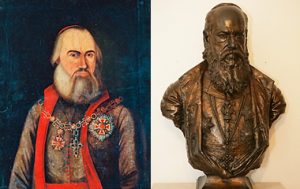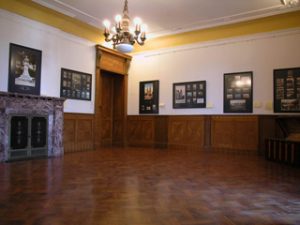Sremski Karlovci Homeland Collection
Sremski Karlovci Homeland Collection
It is located in the Palace Ilion, former residence of the baronial family Rajačić. It is the collection of complex type, and possesses archaeological, historical, ethnological and art collection.






The mentioned collections contain the artefacts that are important for the study of the rich past of Sremski Karlovci.
The museum display consists of several units: the exhibition about Branko Radičević, the peasant cuisine of the late 19th and the early 20th century, paintings by Milić od Mačve, aquarelles by Svetomir Lazić and ceremonial dining room of the family Rajačić.
Branko Radičević, the poet of the epoch of Romanticism, is the most celebrated student of Karlovačka gimnazija (Karlovac High School, the first high school in Serbian nation, founded in 1791). His life was illustrated with photographs, documents and books – different issues of the poems he wrote. Special place take two silver wreaths made on the occasion of the transfer of Branko’s remains from Vienna to Stražilovo (in 1883).
The peasant cuisine, whose appearance is reconstructed thanks to preserved ethnographic artefacts, illustrates rural life in the Fruška gora, from the late 19th and the early 20th century. In the display can be seen kitchen items which wake the memories to visitors, because they were used by their their grandmothers and great-grandmothers.
The legacy of the painter Milić od Mačve is a separate entity. The paintings represent Branko Radičević and motifs of the old Sremski Karlovci. The artist donated 60 paintings – oil on board, aquarelles and some pastels.
The smaller space is occupied by the legacy of an architect, Svetomir Lazić, the student of the High School of Sremski Karlovci. His paintings present Karlovci with its surroundings, as well as some of the European cities, which he visited during his lifetime.
The ceremonial dining room of the family Rajačić, fully preserved, is an exceptional ambient unit. It was made by order, probably in Vienna, at the beginning of the third decade of the 20th century. Its peculiarity lies also in the fact that within last few decades it was situated in so-called “Tito’s saloons” in the Officers’ Pavilion, at Petrovaradin Fortress. Fortunately, all the parts of the dining room have been preserved, so that today it is in its original space.
The Palace Ilion belonged to the baronial family Rajačić. The original house, which was located on the place of today, was built in the first half of the 19th century. In fact, when Josif Rajačić in 1842. was elected the Metropolitan and moved to Karlovci, his nephew Aleksandar Rajačić also moved in. The aforementioned house was purchased in that period.
The present appearance Ilion got in 1920. The building was upgraded and the garden was arranged at that time.
The Metropolitan and later Patriarch Joseph Rajačić often visited the house of his nephew. His secular name was Ilija, and according to one of the assumptions, that is why the name of the palace is ILION. When the Patriarch Josif Rajačić in 1861, a few months before his death, got the title of Baron from the Emperor Franz Josef, it could be transferred to certain branches of his close relatives. Aleksandar Rajačić took then the title of Baron, aas well as the descendants who inherited him – Vlada and Josif Rajačić. After the World War II, in 1947, in one part of the Palace Ilion was moved in the City Museum of Sremski Karlovci (which is from 1963 placed within the City Museum of Novi Sad, and is now called Sremski Karlovci Homeland Collection).
- Palace Ilion – street view
- Palace Ilion – backyard view
- Ceremonial saloon
- The exhibition – Students’ clothing in Serbia from mid-19th century
- The urn from the Bronze Age, Sremski Karlovci
- Petar Ubavkić, Patriarch Georgije Branković
- Georgije Popović, Metropolitan Stefan Stratimirović
- Branko Radičević
Additional Info
City Museum of Novi Sad © 2025.


